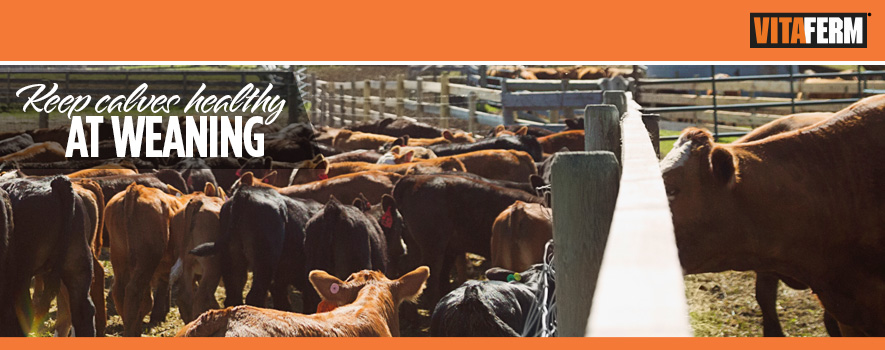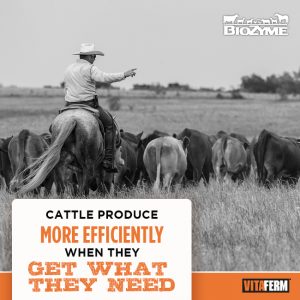
Temperatures are cooling, mama cows and their calves are bawling for each other across the fence line. Weaning time is here, which adds stress to the calves and their immune system. You can keep them healthy by making sure their respiratory and digestive systems are not compromised during this stressful time in their lives. Ensuring a seamless transition from Momma’s milk to feed and forage starts with proper nutrition to maximize performance potential and prevent sickness. Weaning diets need to be considered an investment and not an expense. An investment must have a positive return to be successful, and weaning diets are no exceptions.
A proper nutrition program can help keep respiratory and digestive health in check. In addition to proper nutrition, a vaccination program to increase respiratory disease resistance and help with germ response is vital. A combination of vaccinations and a good diet will help keep respiratory disease at a minimum.
The digestive health of your freshly weaned calves can be compromised if a good feeding program is not planned. Prior to weaning, the primary source of the calf’s diet is milk that is rich in energy and packed with protein, vitamins, minerals and water. Therefore, when a calf is weaned those nutrients must be replaced with a highly palatable combination of roughage, concentrate and supplements. Feed and water intake can sometimes be limited by weaning stress and new surroundings, so every bite needs to count. Scientists have found it sometimes takes calves nearly a week to consume expected amount of receiving diets. Therefore, it is imperative to get calves on feed quickly and safely to avoid lost weight gains and sickness. Reducing stress, making calves comfortable, and providing a highly palatable, nutritious diet makes cattle grow and stay healthy.
Water is often overlooked, but is very important. Cool, clean, quality water is the basis for a successful nutritional program. Water sources should attract calves to their use. Properly designed facilities are critical to making calves comfortable and bringing them to adjust quickly to their surroundings.
Energy needs to be supplied safely and in balance with other nutrients. Starchy feeds, like processed grains, can be effective sources of energy or they can lead to serious digestive upsets, all depending on feed preparation and bunk management. Grinding to small particle size is not necessary as young cattle readily chew their feed. Over feeding starch leads to rumen acidosis, bloat and even death. Non-starch energy can be safe and effective in growing and starting cattle. Grain co-products are readily available, highly palatable and are easy to mix in a ration. Remember that energy consumption will be one of the biggest factors contributing to weight gains of our cattle.
Long-stem hays and other forages can create the benefit of dietary effective fiber. Cud chewing is a good sign of a healthy rumen and is caused by having the right kind and amount of dietary forage. The proper balance between energy and fiber promotes adequate intake taken in numerous small meals daily, promotes near neutral rumen pH and enough energy to meet performance goals.
Protein is another important nutrient. Soybean, cottonseed, sunflower, other pressed grains along with commercial meals and high quality forages are excellent sources of protein. Grain co-products like distillers, gluten, wheat midds, and soybean hulls can be included to balance both protein and energy. Calf diets generally need to contain about 13% protein, however, the first week or two after weaning it can be advantageous to increase the protein to around 16% to compensate for calves that are shy and don’t aggressively come to the bunk.
Minerals and vitamins round out the nutrients that make a great weaning/starter feed. The two major concerns for minerals are the amount in the diet (concentration) and the balance between the specific minerals. For example, calcium and phosphorus have specific requirement levels and they need to in the correct ratio to each other. The calcium to phosphorus ratio needs to be about 2:1 or greater. If the calcium to phosphorus ratio gets low, the male cattle are more susceptible to urinary calculi. Trace mineral especially need to be fed within proper balance and amounts. Vitamins have important roles to many bodily processes. Including vitamins with antioxidant properties (Vitamin E in particular) help tissues repair themselves as rapidly as possible; reducing the time it takes the calves to recover from stress.
Consider using technology when weaning calves. Some producers have used mechanical devices to prevent calves from suckling prior to pair separation to reduce stress. Others use creep feed, fence line methods, pen layouts and soft weaning techniques to destress the cowherd. Research is showing positive results that including a direct fed microbial can greatly benefit the weaning transition. Amaferm®, a natural prebiotic from Biozyme® Inc., is included in all VitaFerm® and Vita Charge® products and has been proven to reduce the time to get cattle on feed, increase post-weaning weight gains and improve health. Including Amaferm in your calves’ feed ration post-weaning will help control their intake of feed, and increase digestibility to ensure they get the most nutrients out of their diets.



